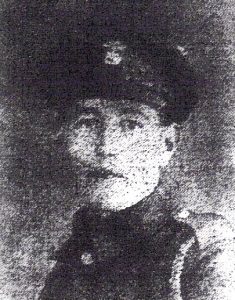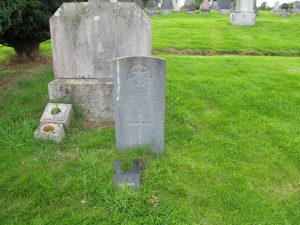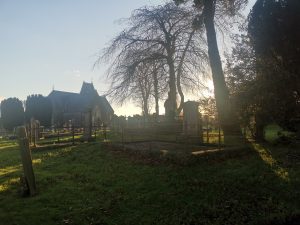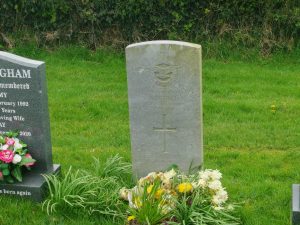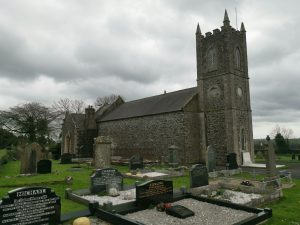Brown, R J (Robert James)

Brown, R J (Robert James)
Private Robert Brown was the son of John and Elizabeth Brown, of Glebe, Glendermott, Drumahoe, Co. Londonderry. Husband of Elizabeth Brown of 50 Ferguson Lane, Londonderry. He served with the 10th Inniskillings Fusiliers and the Labour Corps.
Robert was a farm labourer before he enlisted on the 15th of September 1914. His war though began when he originally landed in Boulogne,[1] France on the 6th of October 1915 at 1:30am along with the 10th Inniskilling Fusiliers. There were 1029 men, all ranks.
At 14.00 they went on a route march with their band from Boulogne, arriving at 10.00 the following day at Gare Central station[2] where they entrained and travelled to Coisy[3] and were billeted. At this point they started training and improving where they slept. Soon they were on the move again. Training continues, and they were eventually attached to other battalions at Hebuterne[4] to help them gain some experience in trench warfare.
Training continued, and the battalion marched from area to area. When the time came to celebrate the “Closing of the Gates of Londonderry (December 1668)”, the battalion still had no casualties or real front-line experience.
During March, they went to Forceville[5] and the trenches at Thiepval Woods[6] where they relieved the 9th Royal Inniskilling Fusiliers and started receiving their first casualties. This continued into April and up until May when they moved to Léalvillers[7] The battalion remained here until mid-June when they moved back to Forceville and the Thiepval Woods area.
On the evening of the 30th of June 1916, the battalion moved forward to take up their positions at Thiepval Woods. Whilst walking through Aveluy Woods[8] towards the trenches the 10th Inniskillings commanding officer, Lieutenant Colonel Ross Smyth slipped and sprained his leg and was evacuated. A bad omen of things to come.
With the 9th and 11th Inniskilling Fusiliers on their right and 14th Royal Irish Rifles with them they waited in crowded trenches on the 1st of July for the bombardment of the German lines to finish. The men were all issued a portion of rum as they paused before putting their training into place and entering “No man’s land”, playing their part on the day of the “Great attack”.[9]
The battalions got mixed up as they advanced causing some confusement and even worse advancing too quickly, this caused heavy casualties from friendly fire. Within 100 yards of the enemy’s trench, they lay down awaiting the moment to attack. The company bugle calls soon followed announcing their orders to advance again.
All-in-all 764 men left the trenches, only 346 returned. The battalion eventually left the front line on the 2nd of July to regroup and rest, but only until August when they were redeployed at Ploegsteert Woods.[10]
Robert Brown was misreported as being dead (while serving with the 10th Inniskillings, A Company) on the 2nd of July 1916. It is known that his mother had been informed. The person who was killed though was not him, but a John Brown[11] of D Company, from the Fountain Estate in the city. It turned out that the army had them both under the same regimental number, 15362. John would eventually take the service number and Robert would have his service recorded under number 13355.
Time passed by whilst the battalion continued to receive casualties and new recruits, raid German trenches, man trenches, bomb, be bombed and repeat. This continued until the end of October when they went to the village of Dranoutre,[12] to rest, bathe and be reissued uniform.
The Inniskillings remained here until mid-November when they set off to the Ypres area of Belgium, to man the trenches at Bailleul,[13] they stayed right through to the end of the year when they moved back to Ploegsteert woods.
While his commander had reported only 2 killed in a mortar attack on the 1st of January 1917, Private Robert Brown was wounded with a gunshot to the right shoulder. He was later discharged on the 11th of May 1917 due to these wounds, being unfit for service.
Robert would though reenlist into the 68th Company of the Labour Corps a year later, on the 10th of May under service number 701916. He was eventually demobilised on the 19th of May 1920.
Private Brown eventually died in 1920 after suffering from pulmonary tuberculosis for five months. He died in the presence of his wife Lizzie, and it is possible that his death may have been a direct consequence of damage done to his lungs by sustained gas attacks during the war.
He was awarded the 1914/15 Star, the British war and Victory Medals, his wife Lizzie acknowledged receipt of them on the 12th of January 1922.
Date of Death: 28/11/1920 (Aged 25)
Service: Private, Royal Inniskilling Fusiliers, 10th Battalion and the 68th Company of the Labour Corps.
Service Number: 15362, 13355, and 701916 (or 702916)
Burial Location: Glendermott Church of Ireland Churchyard and New Cemetery, Old ground South of Church.
[1] Boulogne or Boulogne-sur-Mer is a coastal town in northwest France.
[2] Gare Central station is around 16 miles south of Boulogne.
[3] Coisy is around 60 miles, southeast of Gare Central station.
[4] Hebuterne is an area in France around 20 miles northeast of Coisy.
[5] Forceville in an area in France in between Thiepval Woods and Léalvillers.
[6] Thiepval Woods is around 6 miles south of Hebuterne.
[7] Léalvillers is an area in France around 7 miles east of Thiepval.
[8] Woods just west of Thiepval Woods.
[9] Great attack, later called the battle of the Somme.
[10] Ploegsteert Woods is in southern Belgium about 60 miles north of Thiepval woods.
[11] Private John Brown, 15362 is buried in Puchevillers British Cemetery in France.
[12] Dranoutre is a small village in Belgium around 6 miles west of Ploegsteert Woods.
[13] Bailleul is an area in Belgium 6 miles northeast of Dranoutre.
